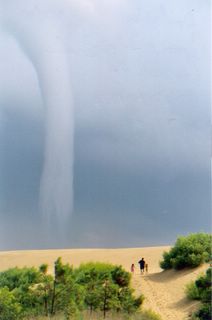NYT - Water-Starved California Slows Development
An article in the NYT on Sat. reminded me of how progressive Dare County governments have been. The piece focused on the impact of water shortages in California. California passed a law that limits growth based on the avaiability of drinking water:
The 2001 state water law, which took effect in 2002, requires developers to prove that new projects have a plan for providing at least 20 years’ worth of water before local water authorities can sign off on them. With the recent problems, more and more local governments are unable to simply approve projects.Some readers might remember how Nags Head and Dare County limited building when it was clear there wasn't adequate capacity to supply them with water. In both cases new plants were built, the RO plant in KDH and the RO plants on Hatteras Island. When adequate capacity was installed the restrictions were lifted. The restrictions were in place on HI for a long time, when the water finally came on line, the island grew like my neighbors lawn after a June rain storm.
“Water is one of our most difficult issues when we are evaluating large-scale projects,” said Lorelei Oviatt, the division chief for the Kern County Planning Department. In cases where developers are unable to present a long-term water plan, “then certainly I can’t recommend they approve” those developments, Ms. Oviatt said.
As the denied building permits indicate, the lack of sufficient water sources could become a serious threat to economic development in California, where the population in 2020 is projected to reach roughly 45 million people, economists say, from its current 38 million. In the end, as water becomes increasingly scarce, its price will have to rise, bringing with it a host of economic consequences, the economists said.
“Water has been seriously under-priced in California,” said Edward E. Leamer, a professor at the Anderson School of Management at the University of California, Los Angeles. “When you ration it or increase its price, it will have an impact on economic growth.”
California doesn't have any easy solutions to its water woes. They have already allocated virutally all the available water and now they are having to reduce consumptions in some areas because of environmental impacts.
Even more significant, a judge in federal district court last year issued a curtailment in pumping from the California Delta — where the Sacramento and San Joaquin Rivers meet and provide water to roughly 25 million Californians — to protect a species of endangered smelt that were becoming trapped in the pumps. Those reductions, from December to June, cut back the state’s water reserves this winter by about one third, according to a consortium of state water boards.
The smelt problem was a powerful indicator of the environmental fallout from the delta’s water system, which was constructed over 50 years ago for a far smaller population.
“We have bad hydrology, compromised infrastructure and our management tools are broken,” said Timothy Quinn, the executive director of the Association of California Water Agencies. “All that paints a fairly grim picture for Californians trying to manage water in the 21st century.”
Dare County was an early adopter of reverse osmosis water filtration. The county has had its share of problems with RO technology but it has performed well overall. The wholesale price of water has been fairly stable over the last 10 years. The rising cost of energy could impact it as RO is a very energy intensive technology. Still, wholesale water prices, which reflect the cost of production for the systemm have been remarkably stable. In 1998 Nags Head averaged about $1.43 per 1,000 gallons and in 2007 the cost was $1.50. Not bad for a ten year span. Retail costs reflect a lot of other factors from salaries to maintenance costs. They have risen a lot more.
Dare County also has about 10% of its peak capacity that has not yet been tapped. The Water Dept. reports the peak day totals for the water system north of Oregon Inlet at 10.4 mgd. The system capacity is listed as 11.5mgd. The average usage is much less, around 50% of capacity. It is that number the county is looking at when it talks about expanding its service area on Roanoke Island.
California sends a good message to our area. It reminds us just how wise we have been planning and using water and how wise we will need to be in and for the future.
Ciao.
Labels: California, conservation, Dare County, NYT, water









0 Comments:
Post a Comment
<< Home